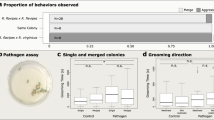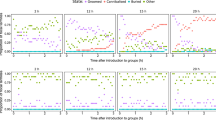Abstract
Individuals living within social groups may benefit from the efficiencies of division of labour, but on the other hand render themselves vulnerable to socially transmitted disease. This cost to social living should promote cooperative barriers to disease transmission, especially in eusocial taxa where spatial and genetic proximity to nestmates are characteristically pronounced. Termites are eusocial yet little is known about how their sociality is deployed to resist contagion. In this study, we manipulate two variables that are expected to affect the number and nature of social interactions and measure the ability of individuals within groups to resist fungal infection. From laboratory experiments on field-collected colonies, we report that both group size and caste composition directly affect the survivorship of individuals within groups, but only caste composition moderates survivorship upon immune challenge. Our study therefore provides no statistical evidence that individual Eastern subterranean termites (Reticulitermes flavipes) have increased resistance to disease in crowded groups—that is, there is no evidence for a density-dependent social immune response. Our results do suggest, however, that the caste-specific nature of interactions may be important for controlling disease in a social context.


Similar content being viewed by others
References
Alexander RD (1974) The evolution of social behavior. Annu Rev Ecol Syst 4:325–384
Bidochka MJ, Khachatourians GG (1994) Basic proteases of entomopathogenic fungi differ in their adsorption properties to insect cuticle. J Invertebr Pathol 64:26–32
Boomsma JJ, Schmid-Hempel P, Hughes WOH (2005) Life histories and parasite pressure across the major groups of social insects. In: Fellowes MHG, Rolff J (eds) Insect evolutionary ecology. CABI, Oxon, UK, pp 139–176
Burgett DM (1997) Antibiotic systems in honey, nectar, and pollen. In: Morse RA, Flottum K (eds) Honey bee pest, predators, and diseases. A.I. Root Co, Medina, OH, pp 455–468
Cox DR (1972) Regression models and life-tables. J R Stat Soc Ser B-Stat Methodol 34:187–220
Cremer S, Armitage SAO, Schmid-Hempel P (2007) Social immunity. Curr Biol 17:R693–R702
Elliot SL, Hart AG (2010) Density-dependent prophylactic immunity reconsidered in the light of host group living and social behavior. Ecology 91:65–72
Evans JD, Aronstein K, Chen YP, Hetru C, Imler J-L, Jiang H, Kanost M, Thompson GJ, Zou Z, Hultmark D (2006) Immune pathways and defence mechanisms in honey bees Apis mellifera. Ins Mol Biol 15:645–656
Fefferman NH, Traniello JFA, Rosengaus RB, Calleri DV (2007) Disease prevention and resistance in social insects: modeling the survival consequences of immunity, hygienic behavior, and colony organization. Behav Ecol Sociobiol 61:565–577
Hamilton WD (1987) Kinship, recognition, disease, and intelligence: constraints of social evolution. In: Itô Y, Brown JL, Kikkawa J (eds) Animal societies: theories and facts. Japan Sci. Soc. Press, Tokyo, pp 81–102
Husby WD (1980) Biological studies on the Eastern subterranean termite Reticulitermes flavipes (Kollar) (Dictyoptera, Rhinotermitidae) in Southern Ontario. In: Department of Environmental Biology, MSc. University of Guelph, Guelph, p 200
Jeanne RL (1999) Group size, productivity, and information flow in social wasps. In: Detrain C, Deneubourg JL, Pasteels JM (eds) Information processing in social insects. Birkhäuser, Basel, pp 3–30
Jeanson R, Fewell JH, Gorelick R, Bertram SM (2007) Emergence of increased division of labor as a function of group size. Behav Ecol Sociobiol 62:289–298
Lainé LV, Wright DJ (2003) The life cycle of Reticulitermes spp. (Isoptera: Rhinotermitidae): what do we know? Bull Entomol Res 93:267–278
Lapidge KL, Oldroyd BP, Spivak M (2002) Seven suggestive quantitative trait loci influence hygienic behavior of honey bees. Naturwissenschaften 89:565–568
Lenz M (2009) Laboratory bioassays with subterranean termites (Isoptera)—the importance of termite biology. Sociobiology 53:573–595
Lenz M, Barrett RA (1984) Implications for comparability of laboratory experiments revealed in studies on the effect of population density on vigour in Coptotermes lacteus (Froggatt) and Nasutitermes exitosus (Hill) (Isoptera: Rhinotermitidae, Termitidae). Bull Entomol Res 74:477–485
Mankowski M, Kaya HK, Grace JK, Sipes BS (2005) Differential susceptibility of subterranean termite castes to entomopathogenic nematodes. Biocontrol Sci Technol 15:367–377
Meikle WG, Mercadier G, Rosengaus RB, Kirk AA, Derouane F, Quimby PC (2005) Evaluation of an entomopathogenic fungus, Paecilomyces fumosoroseus (Wize) Brown and Smith (Deuteromycota: Hyphomycetes) obtained from Formosan subterranean termites (Isop., Rhinotermitidae). J Appl Entomol 129:315–322
Myles TG (1999) Review of secondary reproduction in termites (Insecta: Isoptera) with comments on its role in termite ecology and social evolution. Sociobiology 33:1–91
Myles TG (2002) Isolation of Metarhizium anisopliae (Deuteromycotina: hyphomycetes) from Reticulitermes flavipes (Isoptera: Rhinotermitidae) with convenient methods for its culture and collection of conidia. Sociobiology 40:257–264
Naug D, Gadagkar R (1999) Flexible division of labor mediated by social interactions in an insect colony—a simulation model. J Theor Biol 197:123–133
Pie MR, Rosengaus RB, Traniello JFA (2004) Nest architecture, activity pattern, worker density and the dynamics of disease transmission in social insects. J Theor Biol 226:45–51
Pie MR, Rosengaus RB, Calleri DV, Traniello JFA (2005) Density and disease resistance in group-living insects: do eusocial species exhibit density-dependent prophylaxis? Ethol Ecol Evol 17:41–50
Prestwich GD (1984) Defense mechanisms of termites. Annu Rev Entomol 29:201–232
Raffoul M, Hecnar SJ, Prezioso S, Hecnar D, Thompson GJ (2011) Trap response and genetic structure of Eastern subterranean termites (Isoptera, Rhinotermitidae) in Point Pelee National Park, Ontario, Canada. Can Ent 143:263–271
Rath AC (2000) The use of entomopathogenic fungi for control of termites [Review]. Biocontrol Sci Technol 10:563–581
Ratnieks FLW, Anderson C (1999) Task partitioning in insect societies. Review 46:95–108
Rosengaus RB, Traniello JFA (1997) Pathobiology and disease transmission in dampwood termites [Zootermopsis angusticollis (Isoptera, Termopsidae)] infected with the fungus Metarhizium anisopliae (Deuteromycotina, Hypomycetes). Sociobiology 30:185–195
Rosengaus RB, Traniello JFA (2001) Disease susceptibility and the adaptive nature of colony demography in the dampwood termite Zootermopsis angusticollis. Behav Ecol Sociobiol 50:546–556
Rosengaus RB, Guldin MR, Traniello JFA (1998a) Inhibitory effect of termite fecal pellets on fungal spore germination. J Chem Ecol 24:1697–1706
Rosengaus RB, Maxman AB, Coates LE, Traniello JFA (1998b) Disease resistance: a benefit of sociality in the dampwood termite Zootermopsis angusticollis (Isoptera: Termopsidae). Behav Ecol Sociobiol 44:125–134
Rosengaus RB, Jordan C, Lefebvre ML, Traniello JFA (1999) Pathogen alarm behavior in a termite: a new form of communication in social insects. Naturwissenschaften 86:544–548
Rosengaus RB, Traniello JFA, Lefebvre ML, Carlock DM (2000) The social transmission of disease between adult male and female reproductives of the dampwood termite Zootermopsis angusticollis. Ethol Ecol Evol 12:419–433
Rosengaus RB, Cornelisse T, Guschanski K, Traniello JFA (2007) Inducible immune proteins in the dampwood termite Zootermopsis angusticollis. Naturwissenschaften 94:25–33
Schmid-Hempel P (2005) Evolutionary ecology of insect immune defenses. Annu Rev Entomol 50:529–551
Schmid-Hempel P (2011) Evolutionary parasitology: the integrated study of infections, immunology, ecology, and genetics. Oxford University Press, Oxford
Shimizu S, Yamaji M (2003) Effect of density of the termite, Reticulitermes speratus Kolbe (Isoptera: Rhinotermitidae), on the susceptibilities to Metarhizium anisopliae. Appl Entomol Zoolog 38:125–130
Starks PT, Blackie CA, Thomas D, Seeley PT (2000) Fever in honeybee colonies. Naturwissenschaften 87:229–231
Thompson GJ, Crozier YC, Crozier RH (2003) Isolation and characterization of a termite transferrin gene up-regulated on infection. Insect Mol Biol 12:1–7
Traniello JFA, Rosengaus RB, Savoie K (2002) The development of immunity in a social insect: evidence for the group facilitation of disease resistance. Proc Natl Acad Sci USA 99:6838–6842
Visscher PK (1983) The honey bee way of death: necrophoric behaviour in Apis mellifera colonies. Anim Behav 31:1070–1076
Watson JAL, Okot-Kotber BM, Noirot C (1985) Caste differentiation in social insects. Pergamon, Oxford, p 405
Wilson EO (1971) The insect societies. Belknap Harvard University Press, Cambridge
Wilson-Rich N, Spivak M, Fefferman NH, Starks PT (2009) Genetic, individual, and group facilitation of disease resistance in insect societies. Annu Rev Entomol 54:405–423
Yanagawa A, Shimizu S (2007) Resistance of the termite, Coptotermes formosanus Shiraki to Metarhizium anisopliae due to grooming. Biocontrol 52:75–85
Zoberi MH (1995) Metarhizium anisopliae, a fungal pathogen of Reticulitermes flavipes (Isoptera: Rhinotermitidae). Mycologia 87:354–359
Acknowledgments
We thank Beth MacDougall-Shackleton, Bryan Neff, Yolanda Morbey, Rebeca Rosengaus and all members of the Social Biology Group at the University of Western Ontario for useful discussion and comments, and R Greg Thorn for expert advice on fungal culturing. This work is part of a Doctoral thesis project for QG, and is funded in part by a Natural Sciences and Engineering Research Council Discovery (NSERC) grant to GJT.
Conflict of interest
None.
Author information
Authors and Affiliations
Corresponding author
Rights and permissions
About this article
Cite this article
Gao, Q., Bidochka, M.J. & Thompson, G.J. Effect of group size and caste ratio on individual survivorship and social immunity in a subterranean termite. acta ethol 15, 55–63 (2012). https://doi.org/10.1007/s10211-011-0108-7
Received:
Revised:
Accepted:
Published:
Issue Date:
DOI: https://doi.org/10.1007/s10211-011-0108-7




